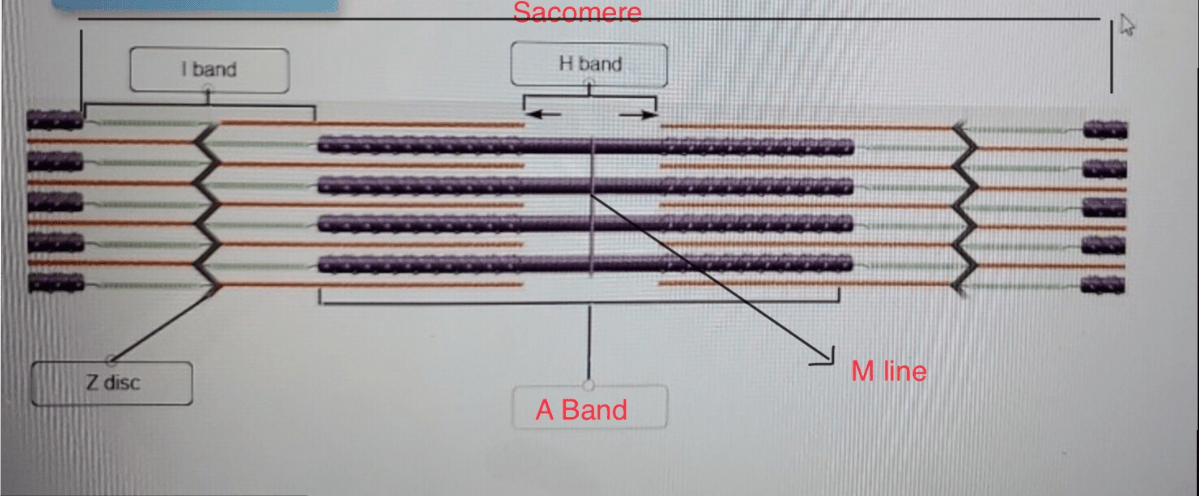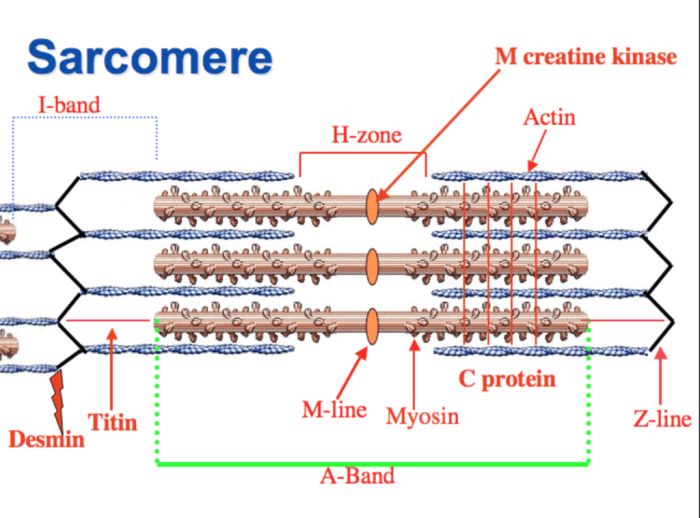Correctly label the different bands of a sarcomere. – Correctly labeling the different bands of a sarcomere is essential for understanding the intricate structure and function of muscle tissue. This guide will provide a step-by-step approach to accurately identify and label these bands, enabling a deeper comprehension of muscle biology.
The sarcomere, the basic unit of muscle contraction, is composed of a repeating pattern of bands that reflect the arrangement and organization of myofilaments. Understanding the structure and function of these bands is crucial for unraveling the mechanisms of muscle movement and force generation.
Sarcomere Structure

The sarcomere is the fundamental contractile unit of skeletal muscle. It is composed of a repeating series of thick and thin myofilaments, which are arranged in a highly organized manner.
Arrangement and Organization of Myofilaments, Correctly label the different bands of a sarcomere.
The thick myofilaments are composed of the protein myosin, while the thin myofilaments are composed of actin. The myofilaments are arranged in a regular pattern, with the thick filaments forming the center of the sarcomere and the thin filaments forming the periphery.
Z-Disk and M-Line
The Z-disk is a protein structure that anchors the thin filaments at the ends of the sarcomere. It is composed of a number of proteins, including α-actinin, which helps to maintain the integrity of the sarcomere.
The M-line is a protein structure that runs through the center of the thick filaments. It is composed of a number of proteins, including myomesin, which helps to maintain the alignment of the thick filaments.
Thin and Thick Filaments
The thin filaments are composed of actin, tropomyosin, and troponin. Actin is a globular protein that forms the backbone of the thin filament. Tropomyosin is a rod-shaped protein that lies along the actin filament and helps to regulate muscle contraction.
Troponin is a complex of three proteins that binds to tropomyosin and helps to regulate muscle contraction.
The thick filaments are composed of myosin. Myosin is a large, rod-shaped protein that has a globular head at one end. The head of the myosin molecule contains an ATP-binding site and a binding site for actin. When ATP is bound to the myosin head, the head can bind to actin and initiate muscle contraction.
Banding Patterns
The sarcomere exhibits a characteristic banding pattern when viewed under a microscope. The bands are named according to their location within the sarcomere.
- The A-band is the central region of the sarcomere and contains both thick and thin filaments.
- The I-band is the region of the sarcomere that contains only thin filaments.
- The H-zone is the central region of the A-band and contains only thick filaments.
- The overlap zones are the regions of the sarcomere where the thick and thin filaments overlap.
Labeling Bands
To correctly label the different bands of a sarcomere, follow these steps:
- Identify the Z-disk. This is the dark line that runs across the center of the sarcomere.
- Identify the A-band. This is the wide, central band of the sarcomere.
- Identify the I-band. This is the narrow, light band that runs on either side of the A-band.
- Identify the H-zone. This is the narrow, light band that runs through the center of the A-band.
- Identify the overlap zones. These are the regions of the sarcomere where the thick and thin filaments overlap.
Essential Questionnaire: Correctly Label The Different Bands Of A Sarcomere.
What is the significance of the A-band?
The A-band represents the thick filament region of the sarcomere and contains myosin heads responsible for muscle contraction.
What is the role of the Z-disk?
The Z-disk anchors the thin filaments and maintains the structural integrity of the sarcomere.
How do the I-bands and H-zones differ?
The I-bands contain only thin filaments, while the H-zones represent the non-overlapping region of thick and thin filaments.


